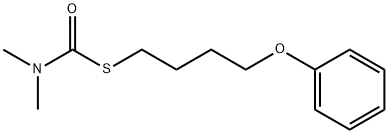Uses
Fenothiocarb is an acaricide used to control the eggs and young
stages of Panonychus citri, Panonychus ulmi and other Panonychus spp.
Definition
ChEBI: Fenothiocarb is an aromatic ether.
Metabolic pathway
When the red mite, applied with 14C-fenothiocarb by
the contact method, metabolizes fenothiocarb,
resulting in several metabolites via the primary
oxidation of the N-methyl moiety. The
photodegradation of fenothiocarb on silica gel plate
exposed to sunlight gives rise to several degradation products. A primary photochemical reaction seems to
be the oxidation of the sulfur atom to form its
sulfoxide. Under greenhouse conditions, when
fenothiocarb is applied to the citrus trees, the major
metabolites identified in the leaves, rinds, and edible
fruit are 6-O-malonyl-b-D-glucosode of N-
hydroxymethyl fenothiocarb, N-formylfenothiocarb, and
glucoside conjugate of phenol (not shown in the map),
respectively. In soils, fenothiocarb is more rapidly
degraded under upland conditions than under flooded
conditions. Main degradation pathways include
oxidation of the sulfur atom which results in the
formation of methyl-4-phenoxybutylsulfoxide, its
sulfone, and 4-phenoxybutylsulfonic acid.
Degradation
Fenothiocarb has long residual activity. It is stable to hydrolysis for 5 days
(pH 5-9, 40 °C) but it is decomposed slowly by sunlight (PM). [U-
14C-phenyl]Fenothiocarb
was applied to the origin of silica gel TLC plates and
exposed to sunlight in September or October. The plates were developed,
with authentic standard compounds also applied, in two dimensions
using different solvent systems. After 72 hours exposure to sunlight, 34%
of parent fenothiocarb remained (DT
50 45 hours). Twelve photoproducts
were detected. Products that were identified are illustrated in Scheme 1
and were N-formyl-fenothiocarb (2), desmethyl-fenothiocarb (3) the
bis(4-phenoxybutyl) thiolsulfinate (4), the bis(4-phenoxybutyl) thiolsulfonate
(5), the sulfoxide derivative (6) and 4-phenoxybutanesulfonic
acid (7). The latter two compounds were major products. The primary
photochemical reaction was oxidation of sulfur to form fenothiocarb
sulfoxide (6) followed by cleavage of the ester linkage and the oxidation
or dimerisation of the 4-phenoxybutanesulfenic acid intermediate. The
second main route of photodegradation was oxidation of the N-methyl
moiety of fenothiocarb (Unai and Tomiwaza, 1986b).




